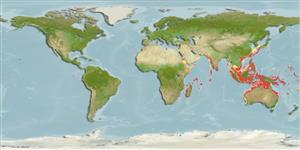Teleostei (teleosts) >
Eupercaria/misc (Various families in series Eupercaria) >
Labridae (Wrasses)
Etymology: Leptojulis: Greek, leptos = thin + Greek, ioulis, a fish dealing with genera Coris or Thalassoma (Ref. 45335).
More on author: Bleeker.
Environment: milieu / climate zone / depth range / distribution range
Ecology
Marine; reef-associated; depth range 4 - 75 m (Ref. 90102). Tropical
Indo-West Pacific: Gulf of Oman to the Philippines and Australia.
Size / Weight / Age
Maturity: Lm ? range ? - ? cm
Max length : 13.0 cm TL male/unsexed; (Ref. 2334)
Found in clear coastal slopes to outer reef lagoons on open rubble patches or rocky bottom (Ref. 48636). Occurs in groups (mostly females) on or near reefs, usually where the water is somewhat turbid and rich in plankton. Fish in the initial phase are much more abundant than the terminal males. Feeds on zooplankton at least a meter above the substrate.
Life cycle and mating behavior
Maturity | Reproduction | Spawning | Eggs | Fecundity | Larvae
Oviparous, distinct pairing during breeding (Ref. 205).
Randall, J.E., 1996. Second revision of the labrid fish genus Leptojulis, with descriptions of two new species. Indo-Pac. Fish. (24):20 p. (Ref. 12420)
IUCN Red List Status (Ref. 130435)
Threat to humans
Harmless
Human uses
Fisheries: minor commercial; aquarium: commercial
More information
ReferencesAquacultureAquaculture profileStrainsGeneticsElectrophoresesHeritabilityDiseasesProcessingNutrientsMass conversion
Tools
Special reports
Download XML
Internet sources
Estimates based on models
Preferred temperature (Ref.
123201): 24.3 - 29, mean 28 °C (based on 1360 cells).
Phylogenetic diversity index (Ref.
82804): PD
50 = 0.5312 [Uniqueness, from 0.5 = low to 2.0 = high].
Bayesian length-weight: a=0.00955 (0.00456 - 0.02002), b=3.06 (2.89 - 3.23), in cm total length, based on LWR estimates for this (Sub)family-body shape (Ref.
93245).
Trophic level (Ref.
69278): 3.4 ±0.45 se; based on food items.
Resilience (Ref.
120179): High, minimum population doubling time less than 15 months (Preliminary K or Fecundity.).
Fishing Vulnerability (Ref.
59153): Low vulnerability (10 of 100).
Nutrients (Ref.
124155): Calcium = 94.5 [55.1, 175.1] mg/100g; Iron = 0.878 [0.502, 1.658] mg/100g; Protein = 18.2 [15.3, 20.4] %; Omega3 = 0.172 [0.102, 0.286] g/100g; Selenium = 27.1 [15.1, 52.2] μg/100g; VitaminA = 222 [67, 805] μg/100g; Zinc = 1.66 [1.11, 2.61] mg/100g (wet weight);
